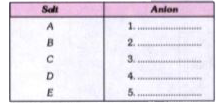Salts A, B, C, D and E undergo reactions (i) to (v) respectively. Identify the anion present in these salts on the basis of these reactions. Tabulate your answers in the format given below:
(i) When silver nitrate solution is added to a solution of A, a white precipitate, insoluble in dilute nitric acid, is formed.
(ii) Addition of dilute hydrochloric acid to B produces a gas which turns lead acetate paper black.
(iii) When a freshly prepared solution of ferrous sulphate is added to a solution of C and concentrated sulphuric acid is gently poured from the side of the test-tube, a brown ring is formed.
(iv) When dilute sulphuric acid is added to D a gas is produced which turns acidified potassium dichromate solution from orange to green.
(v) Addition of dilute hydrochloric acid to E produces an effervescence. The gas produced turns lime water milky but does not affect acidified potassium dichromate solution.

Step by step video & image solution for Salts A, B, C, D and E undergo reactions (i) to (v) respectively. Identify the anion present in these salts on the basis of these reactions. Tabulate your answers in the format given below: (i) When silver nitrate solution is added to a solution of A, a white precipitate, insoluble in dilute nitric acid, is formed. (ii) Addition of dilute hydrochloric acid to B produces a gas which turns lead acetate paper black. (iii) When a freshly prepared solution of ferrous sulphate is added to a solution of C and concentrated sulphuric acid is gently poured from the side of the test-tube, a brown ring is formed. (iv) When dilute sulphuric acid is added to D a gas is produced which turns acidified potassium dichromate solution from orange to green. (v) Addition of dilute hydrochloric acid to E produces an effervescence. The gas produced turns lime water milky but does not affect acidified potassium dichromate solution. by Chemistry experts to help you in doubts & scoring excellent marks in Class 10 exams.
Updated on:21/07/2023Topper's Solved these Questions
- PRACTICAL CHEMISTRY BOOK - ICSECHAPTER - PRACTICAL CHEMISTRY EXERCISE - Questions from Previous ICSE Board Papers (2007)
1 Videos
- PRACTICAL CHEMISTRY BOOK - ICSECHAPTER - PRACTICAL CHEMISTRY EXERCISE - Questions from Previous ICSE Board Papers (2008)
5 Videos
- PRACTICAL CHEMISTRY BOOK - ICSECHAPTER - PRACTICAL CHEMISTRY EXERCISE - WORKSHEET (Tick the correct options)
5 Videos
- PERIODIC TABLE (PERIODIC PROPERTIES AND VARIATION OF PROPERTIES)BOOK - ICSECHAPTER - PERIODIC TABLE (PERIODIC PROPERTIES AND VARIATION OF PROPERTIES)EXERCISE - UNIT TEST PAPER 1-Periodic Table
22 Videos
- QUESTION PAPER 2022 TERM 1BOOK - ICSECHAPTER - QUESTION PAPER 2022 TERM 1EXERCISE - MULTIPLE CHOICE QUESTIONS
40 Videos
Similar Questions
Salts A, B, C, D & E undergo reactions i] to v] respectively. Identify the anion present in each salt.i] When AgNO3 solution is added to a soln. of A, a white precipitate, insoluble in dilute nitric acid, is formed. ii] Addition of dil. HCl to B produces a gas which turns lead acetate paper black. iii] When a freshly prepared solution of FeSO4 is added to a soln. of C and conc. H2SO4 is gently poured from the side of the test-tube, a brown ring is formed. iv] When dil. H2SO4 , is added to D a gas is produced which turns acidified K2Cr2O7 soln. from orange to green v] Addition of dil. HCl to E produced an effervescence. The gas produced turns limewater milky but does not effect acidified K2Cr2O7 soln.
View SolutionIf silver nitrate solution is added to a salt solution and a yellow precipitate is obtained the salt may contain
View Solution
Knowledge Check
A white precipitate is formed when silver nitrate is added to a solution containing chloride ions. This precipitate is soluble in
Hydrochloric acid ; Nitric acid ; Dilute H 2 S O 4 ; Ammonium hydroxide ;AHydrochloric acidBNitric acidCDilute H2SO4DAmmonium hydroxide
Identify the anion present in each of the following compounds :
When barium chloride solution is added to salt solution E a white precipitate insoluble in dilute hydrochloric acid is obtained
View SolutionIdentify the anion present in each of the following compounds :
A salt D on treatment with dilute sulphuric acid produces a gas which turns lime water milky but has no effect on acidified potassium dichromate solution.
View SolutionState one observation each for the following: Silver nitrate solution is added to dilute hydrochloric acid.
View SolutionWrite the reaction of zinc oxide with dilute hydrochloric acid.
View SolutionSalts K, L, M, N and O undergo reaction (i) to (v) respectively with different reagents given below. Identify the cation present in these salts on the basis of these reaction. Tabulate your answer in the format given below:
(i) Addition of potassium chromate solution to a solution of salt K gives a golden yellow precipitate.
(ii) Addition of potassium ferrocyanide solution to a solution of slat L gives a chocolate brown precipitate.
(iii) Addition of potassium ferricyanide solution to a solution of salt M gives an intese deep blue solution.
(iv) Addition of potassium ferrocyanide solution to a solution of O gives a bluish white precipitate.

View SolutionA white sodium salt dissolves in water to give a solution which is neutral to litmus.When silver nitrate solution is added to the solution, a white precipitate is obtained which does not dissolve in dilute HNO3.The anion is
View SolutionState your observations in each of the following:
Lead nitrate solution is added to dilute hydrochloric acid.
View Solution
